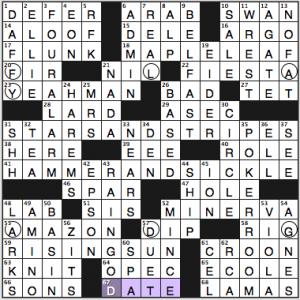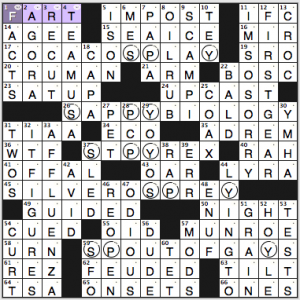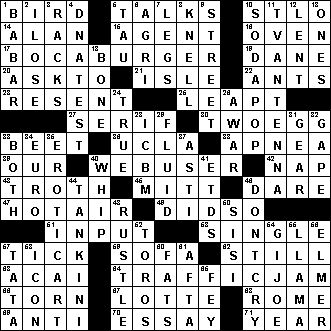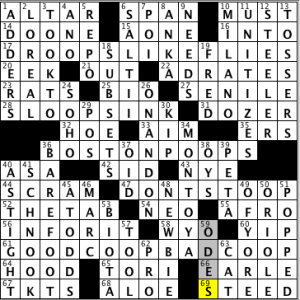NYT 3:36 (Amy)
Tausig untimed (Amy)
LAT 3:05 (Gareth)
CS 11:15 (Ade)
Ian Livengood’s New York Times crossword
This puzzle belongs on Tuesday, June 14, 2016, given that Flag Day is on a Saturday this year and a Sunday next year.
Then again, Flag Day is a US holiday, so the inclusion of other countries’ flags in this theme is squarely wrong. I would have liked the theme a lot better without the circled letters tracing a rectangle and spelling out FLAG DAY, given that three of the flags in the puzzle are entirely irrelevant to the holiday. Anyway, here are the iconic parts of four iconic flags:
- 18a. [Canada], MAPLE LEAF.
- 31a. [U.S.A.], STARS AND STRIPES.
- 41a. [U.S.S.R.], HAMMER AND SICKLE. Wait, what? Why include a flag that was withdrawn 23 years ago when the other three flags are all current?
- 59a. [Japan], RISING SUN.
This may also be thematic, but it adds little except a reminder that this puzzle isn’t running on Flag Day: 67a. [June 14, e.g.], DATE.
So yeah, I have a number of reservations about the theme.
Let’s move on to the rest of the puzzle. Five notes:
- 49d. [Protein-building acid], AMINO. No matter how many times the chemists react poorly, Will Shortz keeps cluing AMINO as if it were a noun. Why? Why not just go with a fill-in-the-blank clue that is scientifically accurate?
- 15a. [“Remove,” to a typesetter], DELE. Wouldn’t proofreader be a little more apt than typesetter here?
- 13d. [Diet food phrase], NO FAT. I wager that a fat majority of labeled fat-free foods use the phrase fat-free rather than no fat.
- 43d. [Tlaloc, to the Aztecs], RAIN GOD. I didn’t know Tlaloc but it wasn’t too hard to guess this anyway. Chicago has no need for a rain god this spring. They should instead head to Texas, California, and Colorado.
- 35d. [Place to play cards], POKER ROOM. I didn’t really know that a POKER ROOM was a thing. It is.
Likes: BELFAST, FOUR-ALARM chili, “YEAH, MAN,” RAIN GOD, MINERVA.
Mehs: DELE, EEE, ELL, one EON and one ALP.
3.25 stars from me.
Ben Tausig’s Ink Well crossword, “Mole People”
A mole is a type of spy, one who lurks within an organization and ferrets out information. Here, Ben has hidden five SPYs in familiar phrases, dramatically altering their meaning.
- 17a. [Dressing up like an Andean stimulant?], COCA COSPLAY. Coca-Cola + SPY meets cosplay, which is dressing up in character costumes but not just for Halloween.
- 26a. [Science that focuses on the sadness and romance of living things?], SAPPY BIOLOGY. A.P biology class + SPY.
- 37a. [Canonized patron of glass measuring cups?], ST. PYREX. The fearsome T. rex + SPY.
- 45a. [Shiny and extremely heavy bird of prey?], SILVER OSPREY. Silver ore, yawn. Here is a silver osprey brooch, if you’re interested.
- 59a. [Garden hose at a pride parade?], SPOUT OF GAYS. Out of gas. Never seen a garden hose at a pride parade but have been sprayed with a Super Soaker by festive parade participants.
 I don’t recall a previous theme that added an entire word but spaced the letters out at different intervals. Definitely helps to have the circled letters, as without them, it would be more of a meta challenge to figure out how the theme answers were formed.
I don’t recall a previous theme that added an entire word but spaced the letters out at different intervals. Definitely helps to have the circled letters, as without them, it would be more of a meta challenge to figure out how the theme answers were formed.
Five more notes:
- 1a. [Comic device used several times in “The Canterbury Tales”], FART. Ah, yes. A word that the daily newspaper puzzles wrinkle their noses at, making itself obvious at 1-Across. And with a fine literary clue, who can complain that it’s low-class?
- Favorite fill: “I’M SO SORRY,” AFFLUENZA, “IT FIGURES,” and TEAM USA (World Cup prospects are dim, yes? and nobody calls the USMNT “Team USA,” do they?).
- 41a. Inedible trimmings], OFFAL? That’s one definition. Another definition of the word is “entrails and internal organs of an animal used as food” (Oxford). Chefs tend to love offal. They can have my share.
- 61a. Native American territory, in slang, with “the”], REZ. You can’t play this in Scrabble, unfortunately. Hey, were you in one of the TV markets that showed the beautiful anti-“Redskins” ad during Tuesday nights’ NBA finals game? We saw it here. (Summary: 2 minutes showing us all the many things Native Americans call themselves—from “daughter” to “Choctaw” to “Geronimo”—and the one thing they don’t, with an image of a Washington Redskins helmet.)
- SRO, TIAA, AD REM, RAH, OID, AGORA, TET, and TEY? Somewhat less smooth than I’d like. Dropping one themer would probably have loosened up the grid some, but Ben is striving for splashy themes in his final month of Ink Well puzzles.
3.75 stars.
Gail Grabowski’s Los Angeles Times crossword – Gareth’s review
A very Monday Wednesday. Then again Gail Grabowski is a constructor I associate with Monday puzzles, it was actually a surprise to see her name so late in the week!
The theme is generic vehicles hidden, or “jammed”, in two-word phrases. I only learnt BOCABURGER recently from a clue Rich Norris wrote for one of my own puzzles! WEBUSER sounds clunky, but does seem to be in use. In full we have:
- [*Big name in veggie patties], BOCABURGER hiding a CAB
- [*Passé reception aid] TVANTENNA hiding a VAN
- [*Certain surfer], WEBUSER hiding a BUS
- [*Steamy gallery display], EROTICART hiding a CAR
- [Rush-hour headache, components of which are hidden in the answers to starred clues], TRAFFICJAM
The rest of the puzzle seems perfectly suited to a Monday. Not a lot of wild, exotic answers for better and for worse. TANKINI struck me as a fresh answer, and it has been positioned next to HOTAIR and EROTICART. Ahem. SODAPOP is also nice. If you want to, you can explore the regional terminology differences for those beverages here (this includes the US only – in RSA, soft drink and occasionally mineral are favoured). It is a strange aspect of human nature that [Dog biscuit shape] is BONE – the dog itself couldn’t care less.
3.5 Stars. I’ll leave you with DONTCRY by G’n’R!
Randolph Ross’s CrosSynergy/Washington Post crossword, “Oops!”—Ade’s write-up
Hello everybody!!
We have a straightforward, yet somewhat tricky crossword for today by Mr. Randolph Ross. Regular phrases are altered by adding an extra “o” and creating an “oop” in the answer (and not always “oops,” like I initially thought would be the case, given the title of the grid).
- DROOPS LIKE FLIES: (17A: [Resembles tired tsetses?)]) – From “drops like flies.” Oops meter count: 1
- SLOOP SINK: (28A: [Sailboat basin?]) – From “slop sink.” Oops meter count: 2.
- BOSTON POOPS: (36A: [Disagreeable Red Sox fans?]) – From “Boston Pops.” Oops meter count: 3. Also, this creates an image in my mind of everyone in Boston going to the bathroom at the same time after eating a bad burrito. Not good.
- DON’T STOOP: (47A: [Advice about posture?]) – From “don’t stop.” Oops meter count: still 3.
- GOOD COOP, BAD COOP: (61A: [The best and worst about henhouses?]) – From “good cop, bad cop.” Oops meter count: still at 3. Best answer of the five themes.
Again, was fooled that each of the themes would have the consecutive letters “oops,” but that eventually proved arbitrary. Was made to look like a SCHNOOK by thinking that (41D: [Dope]), but that’s ok because I loved that entry. Answering L’ORÉAL didn’t do me any favors (2D: [“Because I’m worth it” beauty products brand]), not so much because I didn’t know it, but because I thought of all the different slogans used by different beauty products companies for about two minutes afterward. “Maybe she’s born with it?” No, that’s Maybelline. And on and on it went!
From the “What the **** was I thinking?” department: When digesting the clue for FRED (19D: [Barney’s buddy]), I didn’t think of the Flintstones at all, but about Barney & Friends, and the names of the giant purple dinosaur’s friends. Then I realized I have never watched more than 30 seconds of Barney & Friends, so I would have NO IDEA. Then I realized that the only “memorable” part of that show is the opening theme song (“I love you, you love me…”). Then I realized that song was going to be stuck in my head for the rest of my solving experience. Talk about a real-life earworm nightmare!!!
“Sports will make you smarter” moment of the day: STEELER (12D: [Bradshaw was one]) – Of course, Steeler refers to the Pittsburgh Steelers football team. For those casual football fans, or those who notice sports fashion and don’t necessarily concentrate on the game itself, you may wonder two things while watching the Steelers: What do those three diamonds represent in their logo, and why do they have their logo only affixed onto one side of their helmet? The first one, which is fairly easy, is the Steelmark logo, representing the steel industry. After earlier interpretations, the diamonds represent the three materials used to produce steel: yellow represents coal, orange for iron ore, blue for scrap steel. The logo was created in 1960 by the U.S. Steel Corp. (it now belongs to the American Iron and Steel Institute), and the football team eventually modified the logo for their purposes (e.g. putting the entire “Steelers” name in the logo instead of the standard “Steel”). The team actually had to petition the American Iron and Steel Institute to change the word inside the Steelmark from Steel to Steelers before they could go ahead with their new identity.
Now the answer to the second part of the question is much more fun. In the franchise’s beginning, the Steelers had a gold helmet (instead of the black they sport today) with the number of the player as the decal on each side of the helmet. In 1962, the Steelers decided to remove the numbers on the helmets, but were not sure if a plain, all-gold helmet would go down well with fans. So the equipment manager, before the 1962 season, affixed the Steelmark logo onto the helmet – but only on one side of the helmet – as a trial run. It just so happened that in 1962, the Steelers won their most regular-season games in franchise history up to that point (nine), and before their Playoff Bowl game (the third-place game in the NFL back then), they changed their helmet color from gold to black, but left the logo on one side. And as superstition goes, because of the record-breaking success they had that year, and it coinciding with the logo being put on just one side of the helmet, the look stuck!
Thank you so much everyone, and I’ll talk with you on Thursday!
Take care!
AOK





“Protein-building acid” clues a kind of acid. It’s a reference to “amino acid.” As such, it’s very different than the clue my good friend George Barany and other chemists objected to recently: “Monomer of proteins, informally.” That clue invoked the supplement industry’s marketing of “aminos.” It’s a yucky usage, and I won’t repeat the links that got me in trouble. “Amino” is a noun in that world.
You have to parse today’s clue pretty strictly to cry “noun.” Most AMINO clues (like “Protein acid”) imply “kind of” as editorial shorthand. I would hope the chemists see these clues differently.
Amy, your review today is spot-on. I concur with Martin that today’s AMINO clue is nowhere near as irksome as the one from less than two weeks ago. Still, sometimes the simplest clue is the best: “___ acid” Without thinking about it very hard, that FITB can be answered not only with AMINO, but also with BORIC and OLEIC, none of which require a Ph.D. in biochemistry to answer.
Not a lot to say, except that the majority of those alleged collective nouns, like an exaltation of larks, are entirely obsolete, and I wonder if they were >ever< in use. Personally I've never seen larks in "exaltations" in nature, only singly or maybe in pairs, but possibly Northern Hemisphere species are different.
These terms, rediscovered by Lipton in “An Exaltation of Larks,” were memes of the 15th-century. “The Book of St. Albans” of 1486 listed poetic takes on collective nouns. Skylarks soar vertically while singing, so were given this “venery” collective name. (Venery can mean “venereal” via Venus, or “animals you hunt” via venari, the root of “venison.” And yes, larks were game birds in the 15th century. They still are in Italy.)
“The Book of St. Albans” was a runaway hit, and the terms it invented were well known in its day, but more as a literary device than as working vocabulary. Lipton makes that clear but many more people are familiar with its content through the likes of crossword clues than have actually read the book.
npr’s kurt anderson ran a wonderful contest inviting listeners to create their own collective noun descriptors. enjoy!
http://www.studio360.org/story/the-winners-james-lipton-picks-your-best-collective-nouns/
;-)
Here in my neighborhood, June 14 is also the day of the Brooklyn Gay Pride Parade. So if you say June 14 is Flag Day, please enunciate. We wouldn’t want sloppy diction to provoke a fistfight.
NYT:
Agreed. Vexing, to say the least.
It means the same thing to both parties. The proofreader writes it as a direction to the typesetter, who in turn acts on it. Publishing houses still employ typesetters, though much of the work is automated and electronic.
I’ve never seen lard in a can.
et voilà!
;-)
Interesting that the majority of photos on that page do not include metallic cans of lard! And the cans of lard that do show up are antiques, with plastic tubs o’ lard being the current delivery method.
Dook, I guess you’re just not old enough.
Around these parts, I’ve only seen them in bricks wrapped in that plasticky sheeting that’s so handy to grease baking trays with.
Elaine bakes with lard, obtained from a huge bulk can at the Mexican market. I also use small amounts when cooking Mexican rice or beans.
Once she got some at the supermarket because it was late. The package listed so many extra chemicals I call it “I Can’t Believe It’s Not Lard!”
>…I guess you’re just not old enough.
not sure that i’ve ever seen lard in a can either. but as far as i can tell, that’s why we can check things out on places like google images.
;-)
I thought the clue for 10D was a very poor choice. Memorial Day is about remembering those who have served. There are many more appropriate ways to clue “sale.”
More specifically, Memorial Day honors those who have lost their lives while serving in the military. Veteran’s Day is to honor those who have served.
How is a HOLE part of a round?
Think golf.
Ahh, thank you, Gareth.
Can someone please explain 10A, Pen, ex. and how that equals Swan? What am I missing?
A pen is a female swan.
Re: the Ink Well crossword.
I haven’t seen the clue for TEY, but if it refers to the novelist Josephine TEY, then I’m not sure why this is considered poor fill. Maybe not great for an easy puzzle, but surely this is intended for a fairly experienced solving audience.
-Martin
CrosSynergy: Thank you for furnishing us with that historical design factette, Ade. I had long wondered about the asymmetry but never investigated it.
Am now thinking of the Standells’ “Dirty Water.”
As for the title, it makes sense if you think of it describing the multiple appearances of OOP. That is, it’s pluralized. Agreed that the opening salvo of three OOPSes in a row misleads.